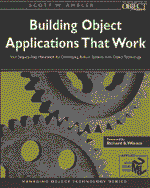 Building Object Applications that Work
Building Object Applications that Work Book contents
- Frontmatter
- Contents
- About the Author
- Foreword
- Preface
- Acknowledgments
- Part I INTRODUCTION TO BUILDING OBJECT APPLICATIONS
- Part II OBJECT-ORIENTED ANALYSIS, DESIGN, AND ARCHITECTURE
- Part III OBJECT-ORIENTED CONSTRUCTION
- Chapter 6 Measuring and Improving the Quality of Your Work—Object-Oriented Metrics
- Chapter 7 Choosing an Object-Oriented Language—Comparing the Leading Languages
- Chapter 8 Building Your Application—Effective Object-Oriented Construction Techniques
- Chapter 9 Making Your Applications Usable—Object-Oriented User Interface Design
- Chapter 10 Making Your Objects Persistent—Object-Orientation and Databases
- Chapter 11 Integrating Legacy Code—Wrapping
- Part IV OBJECT-ORIENTED TESTING
- Part V CONCLUSION
- APPENDICES
- Index
Chapter 6 - Measuring and Improving the Quality of Your Work—Object-Oriented Metrics
from Part III - OBJECT-ORIENTED CONSTRUCTION
Published online by Cambridge University Press: 07 September 2010
- Frontmatter
- Contents
- About the Author
- Foreword
- Preface
- Acknowledgments
- Part I INTRODUCTION TO BUILDING OBJECT APPLICATIONS
- Part II OBJECT-ORIENTED ANALYSIS, DESIGN, AND ARCHITECTURE
- Part III OBJECT-ORIENTED CONSTRUCTION
- Chapter 6 Measuring and Improving the Quality of Your Work—Object-Oriented Metrics
- Chapter 7 Choosing an Object-Oriented Language—Comparing the Leading Languages
- Chapter 8 Building Your Application—Effective Object-Oriented Construction Techniques
- Chapter 9 Making Your Applications Usable—Object-Oriented User Interface Design
- Chapter 10 Making Your Objects Persistent—Object-Orientation and Databases
- Chapter 11 Integrating Legacy Code—Wrapping
- Part IV OBJECT-ORIENTED TESTING
- Part V CONCLUSION
- APPENDICES
- Index
Summary
What We'll Learn in This Chapter
What metrics are and why they're important for object-oriented (OO) development.
Which metrics work for OO and which ones don't.
What metrics to use for estimating projects, improving your development efforts, selecting the right tools, and improving your development process.
How to use metrics effectively on your OO development projects.
Project managers are constantly inundated with questions about the status of their project. How good is our design? Can we start coding now? How long will the project take? How big is the project? How much will it cost? How many people do we need? Questions that are difficult, if not impossible, to answer with any certainty without taking measurements of specific factors that address these issues. But what should you measure? A good question.
One of the reasons, very often the main reason, that firms move into object orientation is that they want to improve the quality of the applications that they develop. They want systems that are easier to maintain. They want systems that are easier to extend. They want to develop systems better, faster, and cheaper. The question is “How do you know that you've succeeded?” In this chapter we'll see that metrics are used to answer this question.
There are a lot of object-oriented (OO) development environments and techniques available to you. Although this sounds good, the problem is that it isn't always clear which ones are the best ones for you.
- Type
- Chapter
- Information
- Building Object Applications that WorkYour Step-by-Step Handbook for Developing Robust Systems with Object Technology, pp. 171 - 196Publisher: Cambridge University PressPrint publication year: 1997
